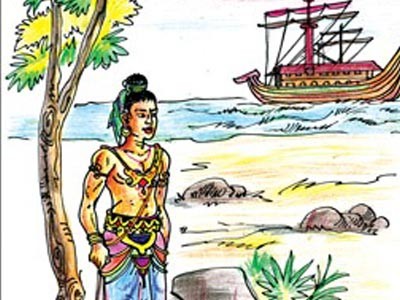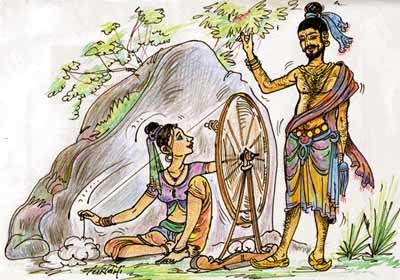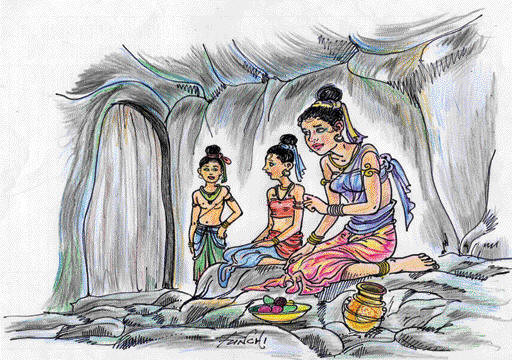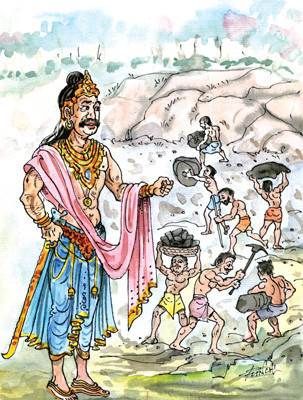Sri Lankan history (part two- the tragedy of the love story)
Sri Lankan history
Sri Lanka is a country with a great history which engaged in tribes, king’s era and colonization. During the early centuries, three types of tribes lived in Sri Lanka which are “Yaksha (Devil), Naga (Snake) and Dewa (God)”. History says, that each tribe had their own abilities to switch their appearance into animal and to have black magic powers.
The Prince Vijaya, banished from India with 700 friends due to the misleading and nasty behavior of the young prince, came to Sri Lanka out of the blue due to a hurricane while traveling by ship.

When the prince kept his first step on the island he saw golden color sand and called the land as “Thamabapani” which means golden sand.
Moreover he saw a dog standing on the beach and he assumed that living creatures must exist on the island. So, young prince chased the dog secretly, but at the end he ended up seeing a beautiful lady under the tree. To his great misfortune, she went away, and the prince sent his friends to find her but none of them came back. So, he decided to go by himself and found out that all his friends have disappeared. He caught the lady, Kuveni by name and the Princess of Yaksha tribe. That was the first meeting of the couple but later it turned into a love story after falling in love with each other. Finally, Prince Vijaya ended up getting married to Kuveni and being the king of Sri Lanka.

The tragedy of the love story
After the marriage Kuveni was expelled from her clan. Prince Vijaya became the king of the country. With the time pass they had two kids, named as “Jivahaththa” and ”Disaala”.
Later, the parents of the king Vijaya suggested him to have the coronation to be legitimate king of the country. To hold a legitimate coronation the king should get marry to a legitimate princess. That's why, Vijaya decided to get marry to an Indian princess. Therefore, he chased Kuveni and the children from the palace.

This is the beginning of the era of the kings. Then the king Vijaya began to place his friends and people from India in different places of the country and started the construction of the villages. They also wanted to have lakes to support the agriculture.

How Sri Lanka became a Buddhist country?
Before introducing Buddhism, Sri Lankan ancestors tend to worship sun, moon and trees since there was no single religion.
According to the history, a great king “Devanampiya Thissa” introduced Buddhism to Sri Lanka as result of friendship between India and Sri Lanka, in 250 BCE, with the arrival of “Mihidu Bikshu”, the son of Emperor Ashoka in India, during the reign of Devanampiya Tissa. As result of this, the king and his followers became Buddhist and supported to spread the religion in the country by constructing temples and other religious places.

Sangamitta Terani, a sibling of Mihidu Bikshu, brought a piece of the Bodhi Tree under which, Lord Buddha get enlightened, to Sri Lanka during this time. This is an important center of worship for Buddhist people. Sangamitta Terani gave the nun ordinance to women devotees for the religion.
Even nowadays, the majority of Sri Lankans are Buddhist and follow the rituals of the religion accurately.
Colonization
Sri Lanka was controlled by kings for a long period. The capital of the country was moved to different areas due to several attacks of enemies time to time. First, the capital had been relocated to Anrdhapura, enriched by historical values. Then gradually, it was moved to Plonnaruwa etc. still we can see the ruins of ancient castles, fortress, canals and temples in the cities where the capital was located. During the king’s era, most of the fortress were surrounded by deep ditches with crocodiles.
But, in 1505, with arrival of Lourenco de Almeida who was a Portuguese, Sri Lanka embraced the fragrance of European. He is the one who found this small island which had been divided into seven kingdoms and ruled by kings. Portuguese found the Colombo port and established accommodations in the city in 1517. Gradually, they expand their area of control over the coast area. Their main purpose was to spread the Catholic religion and gaining other economic benefits. As result of their activities, Sri Lankan people moved the capital to the middle of the country namely, Kandy which is surrounded by mountains and waterfalls. Due to this reason, Portuguese could not win a battle against Sinhalese in this area because of the natural obstacles. The location of the capital was more secure against attack from invaders. Without prior knowledge of the geographical facts about the eastern region, it was very difficult to defeat sinhalese. Portuguese established lot of Missionary camps around the coast area and as result of this, lot of Sinhalese were converted into Catholics.
Later in 1602, Dutch arrived in Sri Lanka and light a sliver shine of freedom in the heart of the king. As a result of this, Rajasinha II and the Dutch captain Jorisvan Spilbergen agreed for a treaty to get the freedom from Portuguese people. According to the treaty, king should grant the monopoly power on the island and Dutch should hand over the control of coastal area of the country to the king. Considering that, the war between Portuguese and Dutch began and Dutch won the war. But breaking the treaty, Dutch took the control of this area in 1658. During this period Sri Lankan people had actually suffered more than the Portuguese era because of high tax burdens.
In 1805, Sri Lanka became a Crown Colony under Britains, who invaded the Kingdom of Kandy after the failure in several wars with Sinhalese in this area.
After discovering the country's lands, Britains realized that the climate was conducive to the cultivation of tea.
That's why, Britains introduced tea, rubber and coffee, and later, Sri Lanka became one of the best tea exporter. During the British colonization era, “Ceylon tea” became very famous over the world. Ceylon was the name which was used by Britains to introduce Sri Lankan to the world during the colonization era.
Due to the production of rubber and the cultivation of tea and coffee, Britain established lot of infrastructure such as railways, roads, harbors in the country which are even today in a good condition.
For the first time in the history, Britain introduced democratic elements to Sri Lanka and the Burghers were given degree of self-government as early as 1833. During this period, English became the official language of the Country. Even though Sinhalese thought colonization was a bad tragedy to the country, Sri Lanka could enrich by modern infrastructures, agricultural exports, foreign languages and new government system.
Photo gallery
Content available in other languages
- Español: Historia de Sri Lanka, (parte dos - la tragedia de la historia de amor)
- Italiano: Storia dello Sri Lanka (Seconda parte - la tragedia della storia d'amore)
- Français: Histoire sri-lankaise, (Partie deux- la tragédie d’une histoire d’amour)
- Français: Histoire sri-lankaise (partie deux- la tragédie d’une histoire d’amour)
Want to have your own Erasmus blog?
If you are experiencing living abroad, you're an avid traveller or want to promote the city where you live... create your own blog and share your adventures!
I want to create my Erasmus blog! →









Comments (1 comments)
Relevant information .... there are plenty of things written in this blog that are important to remember. With basic information, this blog has also put effort into mentioning small details.
Thanks for the details.
I have read some new information regarding Kings of Sri Lanka.. Here is the link
https://srilankatourisminfo.com/sri-lankan-monarchs/